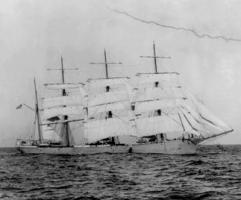 On January 28, 1915, the US flag four-masted bark William P. Frye was sunk off the coast of Brazil by the Imperial German Navy raider SMS Prinz Eitel Friedrich. As a US-owned vessel, William P. Frye was a neutral ship. The US would not enter the war until over two years later, in April 1917.
On January 28, 1915, the US flag four-masted bark William P. Frye was sunk off the coast of Brazil by the Imperial German Navy raider SMS Prinz Eitel Friedrich. As a US-owned vessel, William P. Frye was a neutral ship. The US would not enter the war until over two years later, in April 1917.
Nevertheless, because the bark had sailed with a cargo of wheat from Seattle, Washington bound for Falmouth, England, Max Thierichens, the commander of the German cruiser declared the cargo to be contraband, as it could be used to feed English troops. He demanded that the cargo be dumped overboard. The crew started discharging the approximately 5,000 tones of grain. When they had not completed the job by the next day, the German commander ordered all crew and passengers off the ship, had scuttling charges set, and sank the square-rigger. William P. Frye was the first American vessel sunk during World War I.
William P. Frye was a steel bark built in 1901 by Arthur Sewall & Co of Bath, Maine for their own account. She was 3,374 GRT and 332 feet long.
The SMS Prinz Eitel Friedrich was a passenger liner built in 1904 by Vulkan Stetting Werke. In 1914, she was requisitioned by the German Navy and armed with 4×105 mm and 6×88 mm guns. As a raider, she was responsible for sinking at least 12 ships.
The sinking of the William P. Frye caused considerable indignation in the United States. The German government subsequently apologized and said that the attack was a mistake. Then just over three months later, a German submarine sank the British liner Lusitania, killing more than 1,000 people, including 128 Americans. Despite the uproar, the US would still stay out of the war for almost another two years.
In March 1915, the SMS Prinz Eitel Friedrich put into Newport News, Virginia, in the still neutral United States, due to engine problems. She had aboard 350 passengers and crew from the ships that she had sunk, including crew and passengers from William P. Frye.
US authorities interned the SMS Prinz Eitel Friedrich. In 1917 she was turned over to the US Navy and refitted as a troop transport, USS DeKalb. After the war, she was converted to a steerage only immigrant ship for the United American Line of New York and renamed Mount Clay. The ship operated until 1925 when she was laid up and finally scrapped in 1934.
